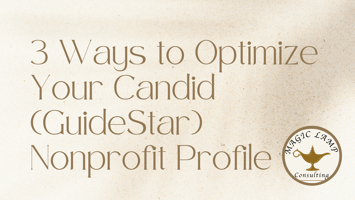How to Align Your Mission with Donor Priorities to Maximize Support

In the competitive world of nonprofit fundraising, understanding how to align your mission with donor priorities is a critical skill. Grantors and stakeholders want to invest in organizations that not only have a meaningful mission but also demonstrate a clear connection to their own values and goals. By crafting a compelling narrative that resonates with donors, nonprofit leaders can increase funding and deepen relationships with key supporters. Together, the Magic Lamp Consulting team has put together a list of ways to create alignment and maximize support for your organization.
The Intersection of Mission and Donor Priorities
At its core, effective fundraising is about finding common ground. Donors, whether they are individuals, foundations, or corporate sponsors, have specific priorities that drive their giving decisions. These priorities often stem from personal values, organizational missions, or philanthropic strategies. To secure their support, nonprofits must identify where their mission intersects with these priorities and articulate that connection clearly.
For example, a foundation focused on environmental sustainability will prioritize organizations that address climate change, conservation, or green technology. If your nonprofit’s mission involves urban gardening programs that reduce food insecurity while promoting sustainability, you’re in a strong position to demonstrate alignment. The key is to tell your story in a way that highlights shared values and objectives.
Researching Donor Priorities
The first step in aligning your mission with donor priorities is understanding what matters most to your potential supporters. This requires thorough research and a proactive approach to gathering information.
- Study donor profiles: Look at the foundation’s past grant recipients, mission statements, and focus areas. For individual donors, try to understand their philanthropic interests through public records, social media, or personal interactions.
- Engage in conversations: When possible, meet with donors or their representatives to learn more about their priorities and expectations. Ask open-ended questions about what drives their giving decisions and what outcomes they hope to achieve.
Not having luck connecting with donors? Did you know our Premium Clients received in-person introductions to established funders aligned with their missions? Message us to learn more how we can save your organization time by expedited aligned relationships focused on increasing your funding. - Monitor trends: Philanthropic priorities can shift based on societal changes, economic conditions, or emerging global issues. Stay informed about these trends to ensure your messaging remains relevant.
By understanding donor motivations and goals, you can position your organization as a partner in achieving their vision.
Crafting a Compelling Narrative
Once you’ve identified areas of alignment, the next step is to craft a narrative that resonates with your donors. A compelling story can bridge the gap between your mission and their priorities, making your organization an irresistible partner in their philanthropic journey.
- Start with your mission: Clearly articulate your organization’s purpose, values, and impact. Avoid jargon or overly technical language—your mission should be easy to understand and emotionally engaging.
- Highlight shared goals: Draw explicit connections between your work and the donor’s priorities. For example, if a corporate sponsor values community engagement, emphasize how your programs bring people together to solve local challenges.
- Use data and stories: Combine quantitative evidence of your impact (e.g., number of people served, measurable outcomes) with qualitative anecdotes that illustrate the human side of your work. This combination creates a narrative that is both credible and emotionally resonant.
- Showcase your capacity: Demonstrate that your organization has the skills, experience, and infrastructure to deliver results. Donors want to invest in nonprofits that can execute their vision effectively.
Remember, your narrative should not only communicate alignment but also inspire action. Use compelling language and visuals to make your case irresistible.
Building Relationships with Donors
Aligning your mission with donor priorities is not a one-time effort—it requires ongoing relationship-building. Strong, authentic relationships foster trust and increase the likelihood of long-term support.
- Personalize your approach: Tailor your communications to reflect each donor’s unique interests and priorities. Generic pitches are less likely to resonate.
- Engage beyond the ask: Keep donors informed about your work through regular updates, invitations to events, and opportunities to see your programs in action. This keeps them emotionally connected to your mission.
- Express gratitude: Recognize the donor’s contributions in meaningful ways, whether through thank-you notes, public acknowledgments, or personal interactions. Gratitude reinforces the partnership and encourages continued support.
- Seek feedback: Ask donors for input on your programs or strategies. This not only strengthens the relationship but also helps you refine your alignment efforts.
By investing time and energy in relationship-building, you create a foundation of trust that can lead to increased funding and collaboration.
Avoiding Mission Creep
While aligning with donor priorities is crucial, it’s equally important to stay true to your organization’s mission. Chasing funding opportunities that don’t align with your core values can lead to mission creep, which undermines your credibility and effectiveness.
To maintain balance:
- Be selective: Only pursue funding opportunities that align with your mission and long-term goals.
- Communicate boundaries: If a donor suggests changes that conflict with your values, respectfully explain why certain directions are not feasible for your organization.
- Revisit your mission: Regularly review your mission statement to ensure it remains central to your decision-making process.
Staying mission-driven not only protects your organization’s integrity but also ensures that your work remains impactful and sustainable.
Measuring and Communicating Impact
Finally, donors want to see results. To maximize support, it’s essential to measure and communicate the impact of your work effectively.
- Set clear metrics: Define specific, measurable goals for your programs and track progress over time.
- Share outcomes: Use reports, newsletters, and social media to highlight your achievements and demonstrate how donor contributions make a difference.
- Celebrate successes: Publicly celebrate milestones and accomplishments, giving credit to your donors for their role in your success.
By showcasing your impact, you reinforce the alignment between your mission and donor priorities, building confidence and enthusiasm for future support.



